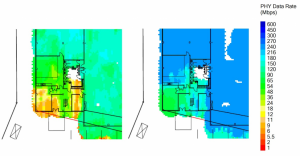Pre-Installation Wi-Fi Survey
Our Approach
Being a wireless-specialist company, Wireless Edge Networks takes pride in delivering quality Wi-Fi surveys to our customers. We believe in the the performance gains that a good Wi-Fi site survey brings. Our focus on the finer details, in-depth knowledge of Wi-Fi and the quality of our site survey reports differentiates us.
All wireless devices are not created equal and some devices perform better that others. The massive growth of mobile devices such as smart phones and tablet devices makes the Wi-Fi site survey a critical step in the design process. We only use the latest industry tools and techniques to map out the RF coverage and capacity of your intended area and provide detailed documentation.
Our Pre-Installation Wi-Fi Survey reports are not bloated with regurgitated diagrams and other irrelevant data – we only focus on what is relevant and provide detailed analysis and interpretation of that data. This includes the following:
- Active survey coverage maps, including signal coverage and related information.
- Detection and identification of RF interference sources.
- Photographs showing the location of new Wi-Fi access points.
- Antenna selection, orientation and polarisation.
- Channel plan and transmit power settings.
- Observations concerning RF multipath, hidden nodes, dead spots etc.
- Full breakdown of Wi-Fi equipment.
Active Wi-Fi Surveys vs Passive Wi-Fi Surveys
We always utlise active surveying when conducting pre-installation site surveys. During an active survey, the WI-Fi adapter is connected to the Wi-Fi access point to measure signal strength and noise levels, as well as round-trip time, throughput rates, packet loss, and retransmissions. During a passive survey, the site survey application passively listens to WLAN traffic, measuring signal strength and noise level. However, the Wi-Fi adapter is not connected to the Wi-Fi network so you miss out on obtaining crucial data that requires connection to the Wi-Fi network. This allows us to report back on potential issues beyond just signal coverage. Active surveys give a more accurate indication of Wi-Fi signal quality, which would not be obtained when performing a passive survey.
To illustrate the difference between an active and passive Wi-Fi survey, the passive site survey predicted a data rate of 86 Mbps but the active survey measured approximately 8 Mbps, which is a significant difference.

Spectrum Analysis / RF Interference
A complete spectrum analysis includes the detection, measurement and recording of RF Interference that could degrade the performance of a wireless network. Interference such as microwaves, PIR sensors, Bluetooth and legacy wireless devices can have a serious impact on your wireless network. We perform a spectrum analysis alongside the acitve survey to ensure any interference sources are identified. This increases the chances of interference detection from devices that are not transmitting constantly. Any interference sources are identified on site plans. The diagram below shows microwave oven interference detected during one of our site surveys.

Configuration Settings
We provide all relevant configuration settings related to your new Wi-Fi deployment. This includes radio channels, antennas, transmit power levels of each wireless access point to maximise the performance of your new Wi-Fi network. We have found in a lot of cases that a static transmit power and channel plan provides the most stability in new Wi-Fi deployments.
If you would like more information, please contact us.